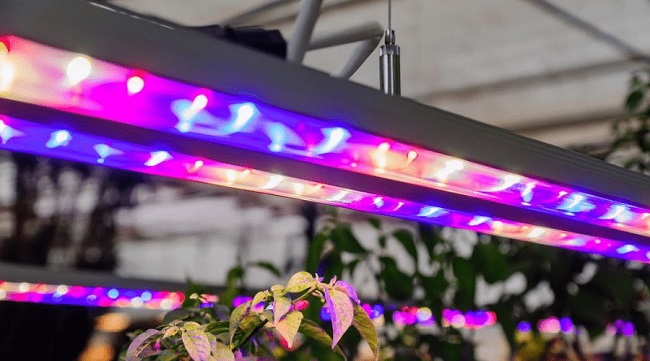
Lighting is an important part of any greenhouse. You’re aiming to replicate the natural light provided by the sun, so a proper understanding of the differences between the main types of greenhouse lighting is critical to growing happy and healthy plants. Light energy is what allows plants to convert water and carbon dioxide into glucose (and oxygen!) through photosynthesis. If your plants don’t have enough light, it doesn’t matter how much you water them—your plants will not grow. Here’s a brief overview of 4 different styles of grow light.
Fluorescent Lights
Fluorescents aren’t really at the same level as the next three lights on this list, and they’re included as a baseline. It’s likely that the lightbulbs in your home are fluorescent. Because of the widespread adoption of fluorescent bulbs as the primary source of light in developed nations, fluorescent light is very inexpensive to purchase. However, they simply do not give off strong enough light to cause vibrant and healthy flowering. If you’re starting out or gardening on a strict budget, you can use a fluorescent light, but we strongly recommend selecting one of the next three models if you’re serious about your lighting setup.
CMH (Ceramic Metal Halide)
Ceramic metal halide lights, commonly abbreviated as CMH, are a type of HID light (High Intensity Discharge). They’re well known for displaying a spectrum of white light that strongly resembles natural sunlight. The ceramic part of the name is important. The arc tube is made of ceramic, which contains mercury, halide salts, and argon. The materials in the light are vaporized to form a plasma, which gives off luminescence. The ceramic tube allows for higher arc tube temperatures, which results in a superior color rendition to traditional metal halide lights. CMH lights do produce a noticeable amount of heat when in use, so they should be elevated away from your plants to avoid burning.
HPS (High Pressure Sodium)
Like the previously mentioned CMH, high pressure sodium lights, commonly abbreviated as HPS, are another form of HID light. These lights have been largely phased out at this point and most growers looking for a HID light will choose a CMH. Xenon is used in HPS instead of argon, the noble gas used in CMH. Its color spectrum is more limited than CMH, which can impact the growth of your plants.
LED (Light Emitting Diode)
HIDs are one portion of the grow light market, but LEDs make up what remains. CMH and LEDs are the primary grow lights used by serious growers, and these lights have the most research going into them. Unlike CMH, an LED does not produce light by superheating gasses until they form plasma. Instead, LEDs operate by passing an electric current through a semiconductor, which is also called a diode. This method of creating light results in much less heat emitted from an LED than from a CMH. Though LEDs have a higher upfront cost than CMH, they do offer savings in power usage and total lifespan. Quality LED grow lights are typically certified for a minimum of 50,000 hours of use, while HID bulbs are typically only good for 20,000 hours of use. However, LEDs can fall short of the natural light spectrum offered by a CMH unless you purchase a more advanced model that incorporates infrared and UV lighting into the LED array.
Though CMH and LED lights are the kings of the grow light industry, the choice of what grow light to use in your greenhouse ultimately falls to you. If you’re planning on building a new greenhouse and are stumped on lighting, reach out to Arcadia Glasshouse at greenhouse@arcadiaglasshouse.com or call 440-357-0022 to explore options for a professional greenhouse installation.
Related Articles & Free Email Newsletter Sign Up
Comparing T5 and T8 Grow Lights for Indoor Gardening
How and When an Indoor Gardener Should Change Grow Light Bulbs
Why Light Meters Can Be Ineffective with LED Grow Lights




Comment here